The following is a list of burial places attributed to Abrahamic figures according to various religious and local traditions. The locations listed are based on locations mentioned in the text of the Bible or oral traditions of indigenous peoples. Many sites have been transmitted from generation to generation and there are historical accounts from travelers which state their existence.
Figures mentioned in the Torah
Further information: Torah| Biblical figure | Place name and location | Image | Notes |
|---|---|---|---|
| Adam | Judaism and Islam: Cave of the Patriarchs, Hebron, West Bank
Christianity: Chapel of Adam, Church of the Holy Sepulchre |
 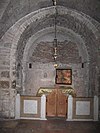
|
|
| Eve | Judaism and Christianity: Cave of the Patriarchs, Hebron, West Bank,
Islam: Tomb of Eve, Jeddah, Saudi Arabia |
 
|
|
| Abel | Nabi Habeel Mosque, Zabadani Valley, Syria | 
|
|
| Seth | In Judaism: Tiberias, Israel
In Islam: Bashshit, Palestine (top), |
 
|
|
| Lamech | Islam: Tomb of Lamech, Mihtarlam, Afghanistan | Seen here | |
| Noah | There are several Islamic sites that are claimed to be the Tomb of Noah:
|
||
| Abraham, Sarah, Isaac, Rebecca, Jacob, Esau, and Leah | Cave of the Patriarchs, Hebron, West Bank | 
|
According to Jewish and Christian tradition, only Esau's head is buried in the Cave of the Patriarchs. According to legends, Ishmael was buried here as well. |
| Ishmael and Hagar | Islam: Hajr Ismail, Mecca, Saudi Arabia | 
|
|
| Lot | Islam: Bani Na'im, near Hebron, West Bank | 
|
|
| Rachel | Rachel's Tomb, outside Bethlehem, West Bank | 
|
|
| Zilpah, Bilhah Jochebed, Zipporah, and Elisheva | Tomb of the Matriarchs, Tiberias, Israel | 
|
|
| Reuben | Nabi Rubin, Palmachim, Israel | 
|
During the Ottoman period, Arabs would gather each year at the Mamluk-era structure. Nowadays, infrequent Jewish visitors come to pray at the site. |
| Judah | Yehud, Israel | 
|
|
| Simeon | Kibbutz Eyal, Israel. | 
|
|
| Asher and Naphtali | Tel Kedesh near Malkia, Israel | Seen here. | |
| Gad | Prophet Jadur Shrine, Ain Al-Jadur, west of Salt, Jordan | 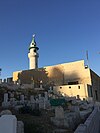
|
The current mosque, built around the tomb, is a modern structure, which dates back to the year 1958. The site has fallen into disrepair and had even been looted as well. |
| Dan | Beit Shemesh, Israel | 
|
|
| Qedar | Mausoleum of Prophet Qeydar, Zanjan, Iran | 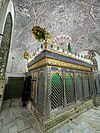
|
Qedar, the son of Ishmael, is believed by the Shi'ites to have been buried in Zanjan. The current mausoleum is a 14th-century reconstruction that has been renovated a few times. |
| Zebulun | Tomb of Zebulun, Sidon, Lebanon | Seen here | Currently a Shi'ite shrine which is still locked to the public. In the past, towards the end of Iyyar, Jews from the most distant parts of Palestine and the Jews who lived in Lebanon would make a pilgrimage to this tomb. |
| Joseph, Ephraim, and Manasseh | Judaism and Christianity: Joseph's Tomb, Nablus (Shechem), West Bank;
Islam: Cave of the Patriarchs, Hebron, West Bank, |

|
Some others consider Joseph to have been buried next to the Cave of the Patriarchs, where a mediaeval structure known as the kalah (castle) is now located.
Some archaeologists believe that the site in Nablus is only the tomb of a Sufi Muslim Shaykh named Yusuf, and not Joseph himself. |
| Benjamin | Kfar Saba, Israel |  
|
Two structures 30 m away from each other (both pictured) are each claimed by Jews, Muslims and Christians as the authentic tomb. This site is questionable, however, because it is not located in the territory of the Tribe of Benjamin. |
| Serah | Pir-i Bakran, near Esfahan, Iran | 
|
|
| Moses | Mount Nebo (Jordan)
Islam: Nabi Musa, West Bank, |

|
According to the Bible, the exact place of Moses' grave remains unknown, in order to impede idolatry. |
| Aaron | Tomb of Aaron: Mount Harun near Petra, Jordan. | 
|
At 1350 meters above sea-level, it is the highest peak in the area; it is believed to be the place where Aaron died and was buried. A 14th-century mosque stands here with its white dome visible from most areas in and around Petra. |
| Eleazar and Ithamar | Awarta, West Bank | 
|
Due to the uncertain security situation, the Israel Defense Forces limits visits by Jews to one annual night close to the 5th of Shevat on the Hebrew calendar (around January–February). |
| Jethro | Nabi Shu'ayb, Hittin | 
|
Each year on April 25, the Druze gather at the site to discuss community affairs. |
| Aholiab | Sujod, Southern Lebanon | 
|
Located at 33.4428°N 35.5381°E. Destroyed after the Israeli occupation of Southern Lebanon. |
Figures mentioned in the Nevi'im (Prophets)
Further information: Nevi'im| Biblical figure | Place name and location | Image | Notes |
|---|---|---|---|
| Nun | Timnath-heres, attributed to Kifl Hares, Salfit Governorate, West Bank | 
|
|
| Joshua | Timnath-heres, attributed to Kifl Hares, Salfit Governorate, West Bank (pictured) Islam: An-Nabi Yusha’ bin Noon aka Prophet Joshua's Shrine, near As-Salt, Jordan. |

|
Thousands make the pilgrimage to his tomb on the annual commemoration of his death, 26th of Nisan on the Hebrew calendar. |
| Caleb | Timnath-heres, attributed to Kifl Hares, Salfit Governorate, West Bank | 
|
|
| Othniel Ben Kenaz | Tomb of Othniel Ben Kenaz in Hebron, West Bank | 
|
|
| Shamgar | Tebnine, Lebanon | Seen here | The tomb is also known by Shia Muslims as the tomb of Prophet Siddiq. |
| Deborah, Barak and Yael | Tel Kaddesh, Israel | 
|
|
| Samson | Beit Shemesh, Israel | 
|
|
| Elkanah | Kedita, Upper Galilee, Israel | See here | |
| Hannah and Samuel | Tomb of Samuel, West Bank.
Christianity: Tomb of Hannah, Horvat Hani, Israel |

|
Both Jewish and Muslim prayers are held at the tomb. Many religious Jews visit the tomb on the 28th of Iyar, the anniversary of Samuel the Prophet's death. |
| Eli | Shiloh, Samaria | 
|
According to Jewish tradition the Yahrzeit of Eli the Cohen is on י' באייר — the tenth day of Iyar. |
| Nathan and Gad | Halhul, Hebron Governorate, West Bank | 
|
The graves of Nathan and Gad are entombed in a mosque named after Jonah. |
| David | David's Tomb, Mount Zion, Jerusalem | 
|
1 Kings 2:10 says that King David was buried in his own city; the City of David is on the southeastern hill of Jerusalem, Mount Zion is its western hill. The "tomb" is a Crusader-era cenotaph (symbolical, empty sarcophagus). The building dates to the 2nd century CE the earliest, and the tradition of David being buried here was created by Byzantine Christians well over a millennium after his supposed death. The authentic tomb of David is probably a cave noted as 'T1' in a former Roman-era quarry outside of the modern city walls. |
| Absalom | Yad Avshalom, Mount of Olives, Jerusalem | 
|
Archaeologists have dated the tomb to the first century CE. Its association with Absalom only dates from the 12th century. Currently it is not considered by any religious group to be the tomb of Absalom, due to its age (1000 years too recent) and the Bible (2 Samuel 18:17, which says Absalom's body was covered over with stones in a pit in the forest of Ephraim). |
| Abner ben Ner | Hebron, West Bank | 
|
Rabbi Moses Basola visited the tomb in 1522. Sefer Yihus ha-Tzaddiqim (Book of Genealogy of the Righteous), a collection of travel writings first published in 1561, mentions the tomb. |
| Isaiah | Isaiah mausoleum, Esfahan, Iran (top) or Nahal Dishon, Israel (bottom) |  
|
|
| Hushai | Yirka, Israel | 
|
|
| Elisha | Elisha's Tomb. Disputed between: near Mt. Carmel, West Bank or Kfar Yassif near Acre, Israel and Eğil, Turkey. | Seen here | |
| Huldah | Mount of Olives, Jerusalem | Seen here | |
| Zedekiah | Cave of Zedekiah, Old City of Jerusalem | 
|
|
| Ezekiel | Ezekiel's Tomb, Al Kifl, Iraq | 
|
Up till the mid-20th century, up to 5,000 Jews used to come to the tomb during Passover. Many Muslims believe this tomb to be that of an unspecified personality named Dhul-Kifl. This site was protected under the control of Saddam Hussein, and renovated extensively in 2014. |
| Baruch ben Neriah | Reportedly in the Al-Nukhailah Mosque, Al-Kifl, Iraq | 
|
Exact location unknown. According to Jewish tradition, Baruch's tomb is located about 1-mile (1.6 km) away from Ezekiel's Tomb near a town called "Mashhad Ali" which there is no record of ever existing.
However, there is a tomb within the Al-Nukhailah Mosque in Al-Kifl dedicated to Baruch. Corresponding with the earlier legend, it is located near to the Tomb of Ezekiel, which is also in the same building. |
| Hosea | Ancient Jewish cemetery of Safed, Israel | 
|
|
| Amittai | Beit Ummar, near Hebron, West Bank | 
|
Mosque of Nabi Matta: The main mosque in Beit Ummar housing the tomb of Nabi Matta or Amittai, father of Jonah. Mujir ad-Din writes that Matta was "a holy man from the people of the house of the prophecy." Nearby Halhul houses the tomb of Jonah with the inscription reading "Yunus ibn Matta" or "Jonah son of Amittai", confirming that Matta is indeed the Arabic name for Amittai and the Beit Ummar tomb is dedicated to Amittai. In 1226, the Ayyubid sultan al-Mu'azzam built a mosque with a minaret under the supervision of Jerusalem governor Rashid ad-Din al-Mu'azzami. The Mamluks constructed some additions to the mosque and engraved several inscriptions on its surface. Also seen here. |
| Jonah | Judaism: Mashhad, Israel. (top)
Islam: Halhul, near Beit Ummar, Hebron. (bottom) |
 
|
Masshad tomb can also be seen here. |
| Micah | Kabul, Israel or also at Jezzine, Lebanon | 
|
The shrine in Jezzine is also known as the tomb of a Prophet Misha. |
| Nahum | Al Qush, south of Dahuk, Iraq. | 
|
There are however two other sites mentioned in historical accounts: Elkesi, near Ramah in the Galilee and Elcesei in the West Bank |
| Habakkuk | Some locate it at Huqoq, others at Kadarim, Israel. There is a shrine in Toyserkan, Iran as well. |   
|
|
| Zephaniah | En-Nabi Safi, Southern Lebanon | Seen here | The tomb is located inside a Muslim shrine, known by locals as the shrine of a Prophet Safi. |
| Haggai, Malachi, and Zechariah | Tomb of the Prophets, Mount of Olives, Jerusalem | 
|
Figures mentioned in the Ketuvim (Writings)
Further information: Ketuvim| Biblical figure | Place name and location | Image | Notes |
|---|---|---|---|
| Job | In Druzism: Chouf District, Lebanon (pictured). | 
|
Yaqut al-Hamawi recorded that it was located in Al-Shaykh Saad, while another tradition locates it at Salalah, Oman |
| Jesse and Ruth | Tomb of Jesse and Ruth, Hebron, West Bank | 
|
|
| Mordecai and Esther | Tomb of Esther and Mordechai, Hamedan, Iran | 
|
Persian Jews still make annual pilgrimage in honor of the Purim festival. |
| Daniel | Tomb of Daniel, Susa, Iran (pictured). There are however six other traditional sites including Kirkuk in Iraq and Samarkand in Uzbekistan | 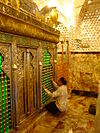
|
At the site in Kirkuk, the locals claim that Hananiah, Mishael, and Azaria are buried alongside Daniel. |
| Ezra | Ezra's Tomb, Al-'Uzayr, near Basra, Iraq | 
|
Preserved by Jewish caretakers until the middle of the 20th century. From that point, a local Muslim Iraqi took the responsibility of preserving the location. The area surrounding the tomb is used today as a place of Muslim worship although Hebrew inscriptions are still present in the room. Located where Tigris and Euphrates meet. |
| Zechariah ben Jehoiada | Tomb of Zechariah, Mount of Olives, Jerusalem | 
|
Figures mentioned in the New Testament
Further information: New Testament| Biblical figure | Place name and location | Image | Notes |
|---|---|---|---|
| Augustus | Mausoleum of Augustus, Rome, Italy | 
|
|
| Caiaphas | Tomb of Caiaphas, Abu Tor, Jerusalem | Discovered by accident in 1990 and subsequently excavated by archaeologists. | |
| Herod the Great | Herodium, Za'atara and Jannatah, West Bank | 
|
Discovered in 2007 by archaeologist Ehud Netzer after 35 years of searching. |
| Saint Andrew | Cathedral of Saint Andrew, Patras, Greece | 
|
|
| Saint Bartholemew | Benevento Cathedral, Benevento, Italy or San Bartolomeo all'Isola, Rome, Italy (bottom) |  
|
Both claimed to contain the relics of Saint Bartholomew. |
| Saint James the Great | Santiago de Compostela Cathedral, Santiago de Compostela, Spain | 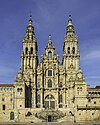
|
|
| Saint James the Less | Cathedral of St. James, Jerusalem (top) or Santi Apostoli, Rome, Italy (bottom) | 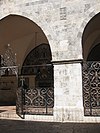 
|
|
| Saint Philip | Hierapolis, Pamukkale, Turkey (top) or Santi Apostoli, Rome, Italy (bottom) |  
|
|
| Saint Paul | Basilica of Saint Paul Outside the Walls, Rome, Italy (top) or Archbasilica of Saint John Lateran (bottom) |  
|
Archbasilica of Saint John Lateran claims the skull of Paul. |
| Saint Peter | St. Peter's Basilica, Vatican City (top) or Archbasilica of Saint John Lateran (bottom) |  
|
Archbasilica of Saint John Lateran claims the skull of Peter. |
| Saint Simon the Zealot and Saint Jude Thaddeus | St. Peter's Basilica, Vatican City | 
|
According to legend, Saint Simon and Saint Jude are buried underneath the St. Joseph altar. |
| Jesus | There are several sites that are claimed to be the Tomb of Jesus:
|
  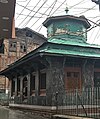 
|
Kirisuto no Haka claims to contain a relic of Jesus's younger brother, Isukiri (speculated to be Joses). |
| Saint Thomas | St. Thomas Cathedral Basilica, Chennai, India or Basilica of San Tommaso Apostolo, Ortona |  
|
|
| Saint Matthias | St. Matthias' Abbey, Trier, Germany | 
|
- Umayyad Mosque, Damascus – John the Baptist (burial site recognised by both Christians and Muslims)
- Basilica of St. John – original burial site of Saint John
- Akeldama, Jerusalem – Judas Iscariot
- Saint Mark's Coptic Orthodox Cathedral (Alexandria) – Saint Mark
- Tomb of the Virgin Mary (in Catholic tradition, Mary was assumed to heaven and has no tomb)
- Abbey of Santa Giustina – Saint Luke (body)
- St. Vitus Cathedral – Saint Luke (head)
- Thebes, Greece – Saint Luke (original burial ground; claimed to still hold one rib)
- Salerno Cathedral – Saint Matthew
- Tomb of Lazarus – Lazarus
- James Ossuary – claimed to hold the relics of James the Just
- Termoli Cathedral – Saint Timothy
- Church of Saint Titus, Heraklion – Saint Titus
Figures mentioned exclusively in the Quran
Further information: Quran| Quranic figure | Place name and location | Image | Notes |
|---|---|---|---|
| Muhammad | Al-Masjid an-Nabawi, Medina, Saudi Arabia | 
|
under Green Dome |
| Hud | Jordan, or Qabr Nabi Hud, Hadhramaut, Yemen | Burial sites near the Zamzam Well or in the Umayyad Mosque are also claimed |
See also
- Burial places of founders of world religions
- List of artifacts in biblical archaeology
- List of Islamic prophets buried in Iran
- List of mausolea
- Lives of the Prophets
- Ohel (grave)
References
- "Mount Damāvand | mountain, Iran". Encyclopedia Britannica. Retrieved 2019-01-23.
- Corbin, Henry (2009). "The configuration of the Temple of the Ka´bah.". Temple and Contemplation. London: Roudledge. p. 227. ISBN 978-0-710-30129-1.
This is the hijr of Ishmael, or the house of Ishmael (Bayt Ismail), where he buried his mother Hagar and where he himself is buried.
- האבות, האמהות, הבנים והנביאים
- דן בן יעקב
- Pilgrimage in Palestine
- Goldman, Shalom (1995). "The Women of the Joseph Story". The Wiles of Women, The Wiles of Men. New York: SUNY Press. p. 115. ISBN 0-7914-2683-1.
- https://archive.today/20130108023424/http://www.syt.co.il/showKever.asp?id=337 אלעזר בן אהרן הכהן
- "Druze Revered Sites in Palestine: Jethro's Tomb". Archived from the original on 2006-05-10. Retrieved 2008-03-25.
- נחלת אשר Archived 2007-03-12 at the Wayback Machine
- Prophet Joshua's Shrine, Tripadvisor, accessed June 2020
- "Otniel ben Knaz". Archived from the original on 2016-03-05. Retrieved 2008-03-25.
- Yeshiva.org.il - המשך ענין לבנון
- Behnegarsoft.com (2011-11-02). "مقام النبي صدّيق في بلدة تبنين جنوب لبنان". وكالة أنباء التقريب (TNA) (in Arabic). Retrieved 2022-05-22.
- מקומות קדושים | קברי צדיקים - הגליל העליון ואצבע הגליל - גבול לבנון - ברק בן אבינעם - SYT
- שמשון הגיבור
- אלקנה
- מקומות קדושים | קברי צדיקים - ירושלים - צפון ירושלים - שמואל הנביא - SYT
- Vamosh, Miriam Feinberg (2018-09-11). "Earliest convent in Israel found at tomb of Samuel's mother Hannah". Haaretz. Retrieved 2024-05-18.
- Jerome Murphy-O'Connor (2008). The Holy Land: An Oxford Archaeological Guide from Earliest Times to 1700. Oxford Archaeological Guides. Oxford: Oxford University Press. pp. 116–117. ISBN 978-0-19-923666-4. Retrieved 19 August 2016.
- Hershel Shanks, Biblical Archaeology Review, January/February 1995, p. 64.
- Kathleen Kenyon, Archaeology in the Holy Land (1985), p. 333.
- Jerome Murphy-O'Connor (2008). The Holy Land: An Oxford Archaeological Guide from Earliest Times to 1700. Oxford Archaeological Guides. Oxford: Oxford University Press. p. 133. ISBN 978-0-19-923666-4. Retrieved 19 August 2016.
- "Tomb of Avner ben Ner (Abner) in Hebron". Archived from the original on 2009-09-03. Retrieved 2008-03-25.
- Avraham, David (1999). In Zion and Jerusalem: The Itinerary of Rabbi Moses Basola 1512-1523. Jerusalem: C G Gundation. ISBN 978-9652229267.
- "URI (ORI) BEN SIMEON - JewishEncyclopedia.com". www.jewishencyclopedia.com. Retrieved 2016-01-04.
- Freedman, Warren. (1984) World Guide for the Jewish Traveler. NY: E.P. Dutton Inc
- AA, Daily Sabah with (2018-12-20). "Drop in dam water reveals submerged village, Elisha's tomb in SE Turkey's Diyarbakır". Daily Sabah. Retrieved 2020-03-25.
- מקומות קדושים | קברי צדיקים - ירושלים - העיר העתיקה - מערת צדקיהו - SYT
- Passover pilgrimage to Ezekiel's tomb in Iraq
- "הושע הנביא". Archived from the original on 2011-07-14. Retrieved 2008-03-26.
- מיכה הנביא
- Renovation- Al Qush Synagogue and the Tomb of Nahum Archived 2012-02-11 at the Wayback Machine.
- חבקוק הנביא Archived 2011-10-01 at the Wayback Machine
- Hukkok
- آلبوم عکسهای تویسرکان
- המשך ענין לבנון
- חגי הנביא
- Caiaphas’ Family Tomb Found, Chicago Tribune, August 14, 1992, .
- Specter, Michael (1992-08-16). "AUGUST 9-15; The Tomb of Caiaphas Unearthed?". The New York Times. ISSN 0362-4331. Retrieved 2023-02-14.
| Holy places in Judaism | |||||||||
|---|---|---|---|---|---|---|---|---|---|
| Holy Land |
| ||||||||
| Tombs of biblical figures |
| ||||||||



